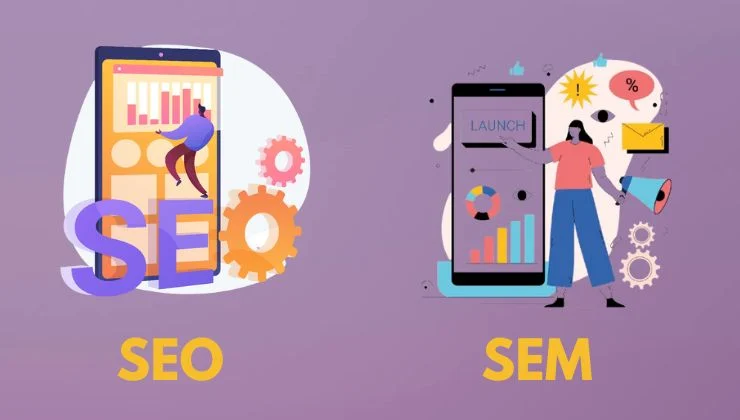SEO and SEM: aren’t they the same thing? While it’s true that both are fundamental strategies within digital marketing, each has its objectives and characteristics. If you have a business and would like to rank it on Google, are a marketing student, or simply want to learn something new about the world of advertising, today we’ll show you the main differences between SEO and SEM. Shall we begin?
First, let’s learn about SEO, including what it is and its various types.
What is SEO (Search Engine Optimization)?
Since we can’t start at the beginning, let’s begin by defining SEO. SEO, or Search Engine Optimization, has as its main objective the ranking of a business or company’s website in search engines like Google, Bing, or Yahoo. You want to be in the top results, as we only look at the first pages when searching. In fact, the first results are usually the ones that receive the most clicks, and this directly affects the number of visits to a website.
By the way, did you know that SEO ranking is organic? In other words, you don’t have to pay Google to index your website. However, this search engine hasn’t made public the guidelines by which it decides to rank one business above another. However, there are several actions that can help us appear in the top ranking, such as quality content, keyword use, and image optimization, among others.
Types of SEO
You only have to look at job postings to realize that SEO has been gaining importance in the strategies of any company looking to gain online visibility. In fact, its evolution is undeniable. But let’s delve a little deeper into the topic. What does SEO actually consist of? What actions must be implemented to rank a website? Well, it depends on the type of SEO we’re working on at the time: on-page SEO, off-page SEO, and technical SEO.
- On-page SEO basically focuses on optimizing all aspects related to content, strategic keywords, images and videos, and the responsive design of the page. In other words, everything within it.
- Off-page SEO, on the other hand, addresses all the factors that are around on the website. We’ll give you some examples. The most common strategy is link building, which seeks to create quality external links to our website on websites with high domain authority or domain rating. Mentions on social media can also help improve our ranking.
- Technical SEO, well, technical SEO encompasses all the actions that facilitate the indexing and crawling of a domain’s pages: good practices in internal linking, improving loading speed of website, reviewing robots.txt and sitemap.xml files, proper URL structure, etc.
What is SEM (Search Engine Marketing)?
SEM, or Search Engine Marketing, also seeks to rank a website at the top of search engine rankings. So, what’s the difference with SEO? Just as SEO is based on organic factors, SEM works through the creation of paid campaigns; you have to spend money on campaigns. Have you ever done a search and found results with the word “Ad”? Here we would be talking about SEM or paid results. Therefore, “search ads” usually appear just before the first SEO results, which means they are more likely to receive a click.
But to create a successful Google Ads campaign, you also need to consider the suitability of the selected keywords, costs, expiration dates, target audience, etc. The key is to get excellent results without having to make a large investment. Another effective strategy is to combine SEO campaigns with SEM campaigns.
1. SEM Basics
Investing in SEM and launching well-optimized strategic campaigns can improve a business’s ROI (Return on Investment). To do so, we recommend familiarizing yourself with the following basic concepts:
2. PPC
PPC, or pay-per-click, is a digital marketing model based on pay-per-click. It’s often used to drive website traffic, promote products or services, and so on.
3. Google Ads Campaigns
Although SEM campaigns can be created on other search engines, Google is definitely the most interesting due to its number of users. Google Ads campaigns consist of creating ad groups related to the type of offer, promotion, or product you want to promote. For example, an online sweet shop may be interested in several ad groups: one for honey sweets, another for rose sweets, and another for almond sweets. Campaigns can also be targeted at seasonal events such as Raksha Bandhan, Diwali, or Christmas. These ads share a budget, launch date, audience type, location, and other parameters.
4. Advertisements
When setting up a campaign, you should also consider the type of ad you want to run. The most common categories are shopping, display (image or video), text, or mobile, but you have many more options. Before choosing one, we recommend considering the campaign’s objectives and who you’d like to target: young people, people living within a certain radius, men or women, etc.
5. Keywords
No less important than the ads themselves are the keywords. In fact, they are the key element when creating optimized ads. Unlike strategic SEO terms, SEM keywords have a cost. It’s very important to choose them well, since advertisers only pay when a user clicks on the ad (CPC, or cost per click). If that user finds the advertised product or service intriguing and ends up purchasing it or contacting the company, the cost will be worth it. However, the same cannot be said if, after clicking, they leave the page without interacting.
What is the Difference Between SEO and SEM?

Throughout this article, we’ve already mentioned some differences between SEM and SEO. The main one is that SEO is organic, while SEM requires paid advertising campaigns. But there are other differences we’d like you to know:
1. Results
Being organic, SEO strategies usually take a little longer to yield results. We’re talking weeks or months, since ranking a term depends on many factors beyond our control, such as Google’s search algorithm. However, once you start seeing the first results and improving the ranking of a strategic term, it’s much easier to maintain it, gain visibility, and increase your domain authority.
SEM, on the other hand, does achieve immediate results. This is because, once a campaign is launched, it begins to appear in search engines. However, just as it doesn’t take months to improve rankings, the moment the campaign ends, user interactions also begin to decline.
2. Costs
Although it’s an organic strategy, SEO also requires a prior financial investment. This is especially true in terms of timescale, the use of specific tools (many of which are paid), and ongoing training. It’s a long-term investment that, once established, has very low maintenance costs.
On the other hand, investing in SEM entails incurring ongoing costs, especially if users click on our ads, in addition to the cost of the campaign itself. But don’t panic. If the ads are optimized and truly target the audience segment we want, we’ll have a better chance of their clicks ultimately turning into conversions.





